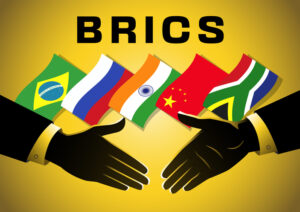Piece by Piece, The BRICS Really Are Building A Multipolar World
The comments below are an edited and abridged synopsis of an article by Hippolyte Fofack
Since its origin in 2001, the BRICS group of Brazil, Russia, India, China and South Africa has emerged as a formidable economic and geopolitical power. The fifteenth BRICS summit in Johannesburg, South Africa has the potential to fast-track the transition to a multipolar world through the expansion of the group and the forging of a new financial architecture not dependent on the US dollar.

Together, the BRICS countries have already overtaken the G7 in terms of their contribution to global GDP, with the group now accounting for almost a third of worldwide economic activity measured by purchasing power parity. The consequences of this economic rise have reverberated through several areas, including trade. While trade between Russia and the G7 has fallen by more than 36% since 2014 due to economic and financial sanctions, trade between it and the BRICS nations has soared, increasing by more than 121% over the same period. China and India have become the largest importers of Russian oil following bans imposed by the EU. China’s trade with Russia hit a record of $188.5 billion last year, a 97% increase from 2014 and around 30% greater than in 2021. The surge occurred as Russia more than doubled its rail exports of liquefied petroleum gas as part of a drive to diversify its exports.
Not complying with western-led economic and financial sanctions is working well for Russia, along with the solidarity of BRICS. It has offered trade diversion and other relief to Russia, a founding member, and in the process, weakened the effectiveness of US-led sanctions as a tool for advancing economic and geopolitical interests.
Up for discussion: A multipolar magnet and the possibility of a new reserve currency.
